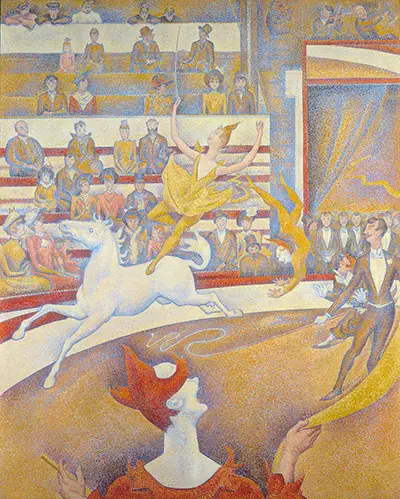The Circus, painted in 1891 is famously regarded as George Seurat’s final work, before he died later that year. Coming slightly after Cancan and Parade, The Circus by Georges Seurat highlights the popular attractions of the modern city. While it falls under the theme covered in the 80’s particularly by artists, such as Degas and Renoir, the Circus is said to be the most impressive for its focus on the Divisionist Theory.
About the Painting
In the painting, Seurat is focused on the interpretation of Charles Henry’s theory, following the psychological effects of colour and line. Although the work was unfinished, the painting was exhibited in the 1891 Salon des Independents, where it raised a lot of criticism for its unique similarities with the works of the French painter Jules Cheret. Some opposed his work, claiming it was a presentation of plagiarism.
The Circus by Seurat showcases a female circus performer, the focal point of the painting, who is seen riding a white horse wildly. She issurrounded by other Parisian acts of the 90s. In the 1890s, circus performers in Paris were given respect, something that was presented in many paintings and stories, such as what was presented by Seurat.
This painting by Seurat has two divisions. The first one depicts the circus artists on the lower right, a characteristic highlighted by spirals and curves, which create a sense of movement. On the upper right is an audience that is seen to be confined in what looks like benches. In the audience is a clear distinction of social classes, whereby in the front row are well-dressed onlookers to reflect wealth, and the poor and low class in the back.
In the foreground is a clown with white make-upcreating space, and on the right is the smartly dressed ringmaster. Other clowns are seen to tumble behind the master. In some part, the clown in the foreground looks like the event organiser, and in another, just a player. He is seen to be in a sad mood and some kind of temper, one that invites laughter from the crowd. The messy hair, upturned hands and the red colour used on the clown’s messy hair and clothes are symbolic of an angry or a sad sensation. On the other hand, the acrobat and the female gymnast on the horse create a sense of elation.
The Style
Seurat paid attention to the Neo-Impressionist Divisionist style, and used pointillist dots to come up with different shades of colour. White dominates the painting, followed closely by yellow, blue and red hues. By the edges is a dark blue border. He is believed to have been influenced by the Japanese graphical prints at the time. Ideally, the Circus by Georges Seurat seeks to create symbolism between scientific analysis and artistic creation, a topic that was popular in the 19th century.




